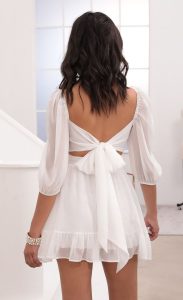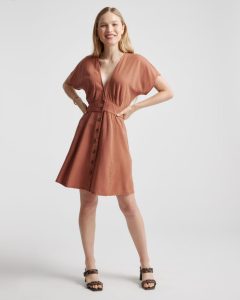Dress codes are a common sight in schools, workplaces, and even some social events. They outline expectations for clothing choices in a particular setting. While some may view them as restrictions, dress codes can serve several purposes. Let’s explore some reasons why dress codes exist.
Fostering a Professional Atmosphere (Workplaces)
In workplaces, dress codes often promote a professional environment. Here’s how:
Credibility and Trust:
Professional attire can project an image of competence and seriousness. This can be important for building trust with clients, colleagues, and customers.
Team Identity:
A dress code can create a sense of team spirit and unity among employees. When everyone dresses similarly, it can foster a feeling of belonging to a shared professional group.
Focus on Work:
Professional attire can help minimize distractions and keep the focus on work tasks. It can set clear boundaries between work life and personal life.

Examples of Workplace Dress Codes (Optional)
Dress codes in workplaces can vary depending on the industry and company culture. Here are some general categories:
-
Business Professional: Suits, dress pants, collared shirts, blouses, and short dresses are common examples.
-
Business Casual: Allows for more relaxed clothing like slacks, khakis, polo shirts, and sweaters.
-
Industry-Specific: Certain workplaces might have specific requirements due to safety or hygiene concerns. For instance, labs might require closed-toe shoes and lab coats.
Creating a Safe and Orderly Environment (Schools)
Schools often implement dress codes to promote a safe and focused learning environment. Here’s why:
-
Minimizing Disruptions: Dress codes can help minimize distractions caused by clothing choices. This allows students to focus on their studies.
-
Safety Concerns: Certain clothing items might pose safety hazards in a school setting. For instance, loose clothing or exposed jewelry could be a risk during physical activities.
-
Equality and Inclusion: A dress code can help create a sense of equality among students by reducing competition or social pressure related to expensive or trendy clothing.

Examples of School Dress Codes (Optional)
School dress codes can vary depending on the school district and age group. Here are some possible elements:
-
Clothing Restrictions: Restrictions might be placed on clothing that reveals too much skin, promotes violence or drugs, or contains offensive language.
-
Appropriate Attire: Schools might specify appropriate clothing types like shirts, pants, skirts, and dresses within a certain modesty standard.
-
Focus on Education: Ultimately, the goal of a school dress code is to create an environment conducive to learning.
Setting the Tone for Events (Social Gatherings)
Dress codes can also be used for social events like weddings, galas, or club functions:
-
Event Theme: A dress code can help establish the formality or theme of the event. For instance, a black-tie event suggests formal attire, while a pool party might call for swimwear.
-
Respectful Attire: Dress codes can ensure guests dress appropriately for the occasion. This shows respect for the host and other attendees.
-
Planning and Coordination: A dress code helps guests plan their outfits in advance, ensuring everyone feels comfortable and confident at the event.

Beyond the Rules: Individuality and Expression
While dress codes establish guidelines, there’s often room for personal expression:
-
Finding Your Style: Even within a dress code, there’s room to showcase your unique style through clothing choices, accessories, or hairstyles.
-
Following the Spirit: The key is to adhere to the overall spirit of the dress code. For instance, a business casual dress code allows for personal flair within a professional context.
-
Open Communication: If you’re unsure about an outfit, it’s always a good idea to communicate with a teacher, employer, or event host beforehand.
Dress codes can serve various purposes depending on the setting. They can promote professionalism, safety, or a specific event atmosphere. However, there’s often room for personal expression within the guidelines. Understanding the reasons behind dress codes can help you navigate these expectations with confidence.
Fostering a Positive Environment (Schools and Workplaces)
In both schools and workplaces, dress codes can contribute to a positive environment. Here’s how:
-
Reduced Distractions: Dress codes can help minimize distractions caused by clothing choices. This allows students to focus on their studies and employees to focus on their work tasks.
-
Sense of Community: A dress code can create a sense of belonging and community among students or employees. When everyone dresses in a similar style, it can visually represent a shared purpose or identity.
-
Professionalism (Workplaces): In workplaces, professional attire can project an image of competence and seriousness. This can be important for building trust with clients, colleagues, and customers.
Examples of Dress Codes (Optional)
Dress codes can vary depending on the industry, company culture, or school district. Here are some general categories:
-
Schools: Schools might have dress codes that limit revealing clothing, promote modesty, or avoid clothing that could be unsafe during activities.
-
Workplaces: Business professional, business casual, and industry-specific dress codes are all common.
Setting the Tone for Events (Social Gatherings)
It can also be used for social events like weddings, galas, or club functions:
-
Event Theme: A dress code can help establish the formality or theme of the event. For instance, a black-tie event suggests formal attire, while a pool party might call for swimwear.
-
Respectful Attire: It can ensure guests dress appropriately for the occasion. This shows respect for the host and other attendees.
-
Planning and Coordination: A dress code helps guests plan their outfits in advance, ensuring everyone feels comfortable and confident at the event.
Finding Your Style Within the Guidelines
While it establish guidelines, there’s often room for personal expression:
-
Making Choices: Even within a dress code, you can showcase your unique style through clothing choices, accessories, or hairstyles.
-
Following the Spirit: The key is to adhere to the overall spirit of the dress code. For instance, a business casual dress code allows for personal flair within a professional context.
-
Open Communication: If you’re unsure about an outfit, it’s always a good idea to communicate with a teacher, employer, or event host beforehand.
Conclusion
It can serve various purposes depending on the setting. They can promote a positive environment, set the tone for an event, or ensure respectful attire. However, there’s often room for personal expression within the guidelines. Understanding the reasons behind dress codes can help you navigate these expectations with confidence.


